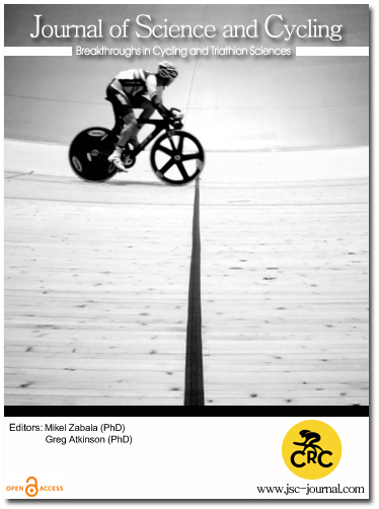Validation of Lactate Minimum Power testing in cyclists
Keywords:
Exercise testing, Performance, Anaerobic threshold, Test protocol, Maximal lactate steady stateAbstract
Introduction- Physiological profiling of elite endurance athletes shouldinclude determination maximal lactate steady state (MLSS) and VO2max. To improve determination of these two parameters in a single test session, we used the “lactate minimum power (LMP)” concept proposed by Tegtbur et al. in 1993. This procedure involves a maximal exercise bout to first substantially elevate blood lactate concentration, where after a submaximal incremental exercise bout, gradually shifts blood lactate balance from net lactate clearance to net accumulation. The nadir of the U-shaped blood lactate curve so obtained is believed to identify MLSS exercise intensity. The validity and accuracy to determine MLSS using LMP in endurance athletes is poorly documented. (Messias 2017) Furthermore, the effect of different maximal exercise bouts to elevate blood lactate has not yet been clarified. (Smith 2002)
Purpose-In the current study we aimed to evaluate (1) the validity of LMP to determine MLSS, and (2) to evaluate the influence of two different maximal exercise bouts on LMP.
Methods- Ten male well-trained cyclists (VO2max 61 ± 7ml•kg-1•min-1) completed a series of tests on different days: a long maximal incremental exercise test (100W + 40W per 8 min); an LMP protocol; 2 or 3 constant-load MLSS tests. The personal race bikes of the participants were mounted on a stationary cycling ergometer (Avantronic Cyclus II, Germany). During the maximal incremental test the first lactate threshold was determined as the exercise intensity corresponding to a +0.5mmol•l-1blood lactate increment above baseline, and MLSS was estimated by the lowest workload eliciting a >1mmol•l-1rise from min 4 to 8. The LMP protocol started with a long incremental exercise phase until the first lactate threshold was determined. Immediately followed by a VO2max ramp (100W +25W per 30sec) to increase blood lactate concentration. Upon exhaustion workload was reduced to 85% of the predicted MLSS, where after workload was increased by 5% of predicted MLSS per 3 min till volitional exhaustion. Blood lactate was measured at the end of each step. MLSS in the constant-load tests was taken as the highest workload, which could be maintained for 30min with a constant ( 1mmol•l-1) blood lactate level between min 10 and 30. To evaluate two different maximal exercise bouts, ten male cyclists (VO2max 65 ± 7ml•kg-1•min-1) completed two tests on different days with 7 days of rest in between: The LMP protocol using either a VO2max ramp (VR) protocol to raise blood lactate level or a 90s all- out exercise bout (90S).
Results- MLSS power output determined from the constant-load tests was 265 ± 38W. MLSS prediction from the LMP test was 270 ± 37W (p>0.05), and LMP was closely correlated with the true MLSS (r=0.93, p<0.05). VO2max was slightly higher in the short ramp protocol than in the long incremental exercise test (63.9 ± 7.1 vs. 61.4 ± 6.9 ml•min-1•kg-1, p<0.05). Bland-Altman scatterplots for LMP and MLSS (figure 1) show small variability with a bias equal to 5.7 ± 13.8 Watt and 4.1 ± 7.2 bpm (mean ± SD).LMP was identical in both protocols (VR, 253 ± 19 Watt; 90S, 253 ± 23 Watt). Corresponding heart rates also were similar (VR, 170 ± 8 bpm; 90S, 171 ± 9 bpm). Both LMP power (r=0.95, P<.0001) and heart rates (r=0.74, P=.023) were highly correlated between VR and 90S. The bland-Altman scatterplot shows no bias (0 ± 7.4 Watt, 0.9 ± 6.0 bpm, mean ± SD) between 90S and VR (figure 2).
Conclusion- To conclude, the LMP test including a VO2max ramp, yields valid measurements of both MLSS and VO2max. LMP was identical in both protocols used.
Downloads
Published
How to Cite
Issue
Section
Copyright (c) 2020 Journal of Science and Cycling

This work is licensed under a Creative Commons Attribution-NonCommercial 4.0 International License.
Authors contributing to Journal of Science and Cycling agree to publish their articles under a Creative Commons CC BY-NC-ND license, allowing third parties to copy and redistribute the material in any medium or format, and to remix, transform, and build upon the material, for any purpose, even commercially, under the condition that appropriate credit is given, that a link to the license is provided, and that you indicate if changes were made. You may do so in any reasonable manner, but not in any way that suggests the licensor endorses you or your use.
Authors retain copyright of their work, with first publication rights granted to Cycling Research Center.






